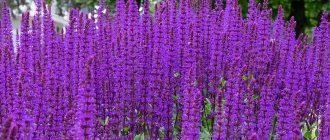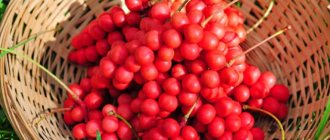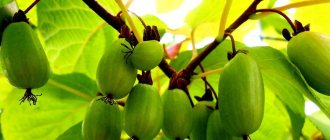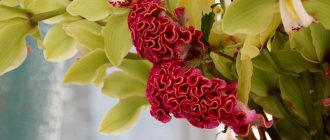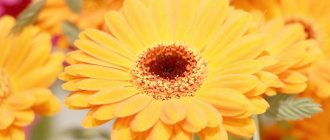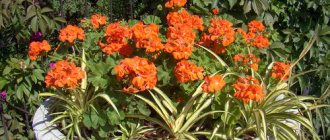Chinese lemongrass (Schisandra chinensis) is an extremely useful plant, often called the medicinal or lemon tree. In the natural environment, it is most often found in Japan, China, Korea, and the Russian Far East; the peak of domestication occurs in these same territories. In other parts of the Russian state, gardeners are wary of planting it, believing that growing and caring for Chinese lemongrass will cause a lot of trouble. This is a very common misconception; this representative of the flora is completely unpretentious to weather conditions and maintenance.
Description of the plant with photo
Chinese lemongrass looks like a vine adorned with flowers or clusters of scarlet berries, depending on the time of year. Its length can reach 10-15 m, so most often the wall of a house or gazebo becomes a support for the curling stems; sometimes special structures like an arch are used. The bush is deciduous, so the area will not always have thick green foliage. But this is a minor minus, considering the benefits that the fruits of schizandra will bring.
The lemon tree was named so due to the citrus scent of the same name emanating from its bark, flowers and fruits. The plant has no other parameters similar to lemon.
The crop blooms in May-June, when the thin and pliable branches of lemongrass are decorated with white oblong buds. But their life is not long-term; such beauty will please the eye for only a couple of weeks. The fruits will be ready for eating only by the beginning of autumn.
Growing conditions
Schisandra is a rather unpretentious, and at the same time exotic plant that cannot be found in every area. If you choose the right place and prepare the soil for planting, its cultivation will not cause problems, but on the contrary will bring great pleasure to the gardener.
Choosing a site for lemongrass
The overall development of the plant and its protection from diseases depends on the correct choice of the site for planting.
Choosing a place to plant lemongrass
It is important to consider the conditions that the culture likes:
- Good lighting, daylight should last at least 8 hours. Therefore, choose the south side when planting near garden buildings and buildings;
- Closedness from drafts and weathering. Protection from icy, frosty winds is especially important; this can be fatal to the plant.
- Places where the plant can curl are considered convenient for planting. Near any type of building - a fence, gazebo, arch, special trellis.
Soil preparation
Before planting, the soil must first be prepared. The following procedures must be carried out:
- loosening;
- fertilization with humus and peat, or wood ash, superphosphate and ammonium nitrate;
- drainage with river pebbles or bricks;
- deoxidize the soil to an acidity close to neutral.
Planting and care
Schisandra is very popular among gardeners in China. In Russia, few people decide to grow this plant on their land, worrying about the requirements of the Far Eastern beauty. But Schisandra’s wish list is very small; using this knowledge, you can plant it near your house without any problems, but you need to do it correctly.
- It is recommended to place at least three seedlings at a permanent planting site. Since lemongrass is cross-pollinated, the absence of fellow plants nearby will not allow the bush to bear fruit. The distance between sprouts should be about 1 m;
- It is optimal to use seedlings aged 2-3 years. They already have a fairly developed root system in order to independently cope with climatic conditions and provide themselves with the necessary substances;
When planting, it is worth considering a place for a trellis, to which the vine can cling to its branches. If we neglect this fact, lemongrass can leave the gardener without a harvest.
- The medicinal tree is demanding of the soil; it must be fertile and ventilated, easily allowing water to pass through. Don't forget about good drainage. Before planting, the soil must warm up by at least 10 degrees; a drop in temperature must be excluded;
- For seedlings, a hole is dug at least 40 cm deep and 50-70 cm in diameter. Schizandra needs to be planted in open ground;
- A 10cm layer of drainage is laid at the bottom of the hole. For this purpose, a combination of crushed stone, gravel and coarse sand is usually used;
- A nutrient mixture is poured into the planting hole, which will provide a more abundant harvest in the future.
- After planting, the soil around the tree trunk needs to be compacted.
- Chinese lemongrass is heat-loving, but can also grow in the shade. However, in this case, maximum fruitfulness will not be achieved. The vine does not tolerate cold wind; you need to create an obstacle to its penetration.
- Newly planted lemongrass requires a large amount of water, so at first you need to actively water it, but do not allow destructive overflow.
- Feeding is carried out only after the third year of life in spring and summer. Once every 2-3 weeks, organic fertilizers (manure) are added to the soil. During flowering, the soil is fertilized with a powder of 60 g of superphosphate and 40 g of potassium sulfide.
Experienced gardeners recommend mixing leaf compost, turf soil and humus in equal proportions. Add 250g of superphosphate and 0.5 kg of wood ash.
These are the basic rules for planting and caring for a Chinese healer. The remaining criteria should be selected based on the region in which it was decided to plant the plant.
Botanical description
The plant is a climbing deciduous vine up to 15 m long with a trunk up to 2.5 cm in diameter and shoots covered with brown-brown bark, flaky on old ones, and shiny and smooth on young ones. Both the shoots and leaves of lemongrass have a characteristic citrus aroma, from which the plant gets its name.
The leaves of Schisandra are dense, obovate or elliptical, with a wedge-shaped base and a few and indistinct teeth along the edges. The leaves are connected to the shoots by pink or red petioles up to 3 cm long. In spring and summer, the upper part of the leaf blade is light green, shiny, bare, and the lower part is bluish, with pubescence along the veins. In autumn, the leaves of Schisandra chinensis turn yellow-orange and ocher-yellow.
Growing lemongrass: planting and care in open ground
Fragrant, waxy white dioecious flowers up to 2 cm in diameter on drooping pedicels are located in groups of 3-5 in the leaf axils. The aggregate racemose fruit, up to 10 cm long, consists of edible spherical two-seeded berries of red color and sour taste. The berries of Chinese lemongrass also have a characteristic smell of the plant. The kidney-shaped seeds of Schisandra chinensis remain viable only until spring.
- How to place grape vines on a trellis in spring
In the Urals
The Urals belong to the temperate climate zone, like most of Siberia. Here, planting should be taken as responsibly as possible, since an already planted plant should not be attacked by cold weather. The soil of the seedlings should not become colder than 10 degrees, otherwise they may die.
The time itself falls at the end of April - beginning of May. To avoid unpleasant consequences, you can cover the permanent place for the growth of vines with an organic cloth, after loosening the soil. This will help keep you warm.
For active growth of lemongrass, you need to plant it on the sunny side. In the conditions of the Urals and Siberia, the plant must receive nourishment from the sun constantly.
Here gardeners recommend using a variety of Chinese lemongrass called “firstborn” for planting. It is more frost-resistant, but in winter it is still better to cover young shoots with a layer of leaves.
5.Home care
Schisandra can be grown not only in the garden, but also at home. Plants are installed on a southeast or southwest windowsill. If the vine is large in size, then it is grown in a floor pot, in close proximity to the window.
Every 2 weeks, the pot is rotated around its own axis a quarter turn so that the vine does not stretch towards the light source and develops evenly.
Pruning and shaping are carried out more radically, maintaining a compact shape and removing old and diseased shoots.
Water the plants with water at room temperature until the soil is completely soaked. After watering, excess moisture is immediately removed from the pan.
↑ Up,
Plants prefer to be in well-ventilated areas without cold drafts. There should be sufficient air movement in the rooms at all times.
In the warm season, pots with lemongrass are taken out into the fresh air - into the garden, placed under the shade of trees or on the balcony. You should not immediately change the location of the flower - the plants are accustomed to any changes gradually, over the course of a week.
Since a flower in a pot has a limited feeding area, for proper development and flowering it will need regular feeding, which is carried out from spring to autumn. Fertilizers are applied to moist soil immediately after watering.
The main difficulty in growing lemongrass is the cool dormant period. In autumn, after leaf fall, the frequency of watering is reduced so that the vine is in a barely moist substrate.
The air temperature is gradually lowered over the course of a week to 4 - 6 degrees Celsius - you can send the plants to the basement or take them out to an unheated balcony.
In the spring, with the first signs of new growth, the flower is taken out of the basement and brought into a warm room, the pot is placed in a bright place.
As with growing outdoors, plants must be provided with support.
Transplantation into new soil is carried out every spring. For young bushes, gradually increase the size of the pot when transplanting. For adult tub plants, the transplanting of which is difficult due to their size, it is enough to replace the top layer of soil 5-7 cm thick in the spring with a fresh soil mixture.
↑ Up,
On South
Here, due to the hot climate, the conditions will be as comfortable as possible for the growth of Chinese vines. The landing time often falls in September or even early October. This time period is due to the almost complete absence of severe winters, the onset of which requires a well-developed root and complete adaptation to the weather.
As elsewhere, in the southern regions you need to carefully examine the roots of the future tree before planting. Their length needs to be adjusted to 20-25cm, and dried or rotten parts must be removed.
There is nothing impossible or supernatural in the process of placing young shoots in your garden. In comfortable conditions, seedlings quickly adapt to the terrain, and in a few years it will be possible to harvest the first harvest from the flexible branches of their wards.
Appearance
First of all, it’s worth talking about the appearance. It is quite unusual: most of all the plant resembles a liana. Moreover, in warmer climates its length can reach ten or even fifteen meters! True, in the harsh Moscow region with relatively short summers and cold winters, the plant rarely exceeds four meters. The thickness of the stem is small (about two centimeters). The bark is wrinkled and dark brown. The vine wraps around almost any suitable object: from a tree growing nearby to a long cord or stake.
The leaves are large, about three to five wide, and up to ten centimeters long.
The flowers are not too large, about one and a half centimeters in diameter, and have a pronounced aroma. The color is predominantly white, but towards the end of flowering they turn pink. Collected in fairly large inflorescences.
After the flowering season ends, they turn into small berries that turn deep red as they ripen. They taste bitterish-burning with a pronounced taste of spice.
How to collect fruits
The lemon tree begins to actively bear fruit only after 4-6 years. The white flowers are replaced by clusters of fiery berries that exude a citrus aroma. You need to remove them with a whole brush, and then separate each berry from the cutting separately.
Determining the maturity of the fetus is not so difficult. If you lightly flick the bunch with your fingers, the ripe and ready-to-eat berries will fall off. The harvest period occurs at the beginning of autumn.
The use of medicinal berries is very diverse: they are used to make compote, jam, homemade alcoholic drinks, medicinal tinctures and eaten fresh. The leaves and branches along with the bark can be dried and used as tea leaves.
But the berries are stored for only a few days, so you need to quickly find a use for them so that they do not spoil.
Common varieties
Rhododendron Dahurian Far East
The most common types of lemongrass are:
- Chinese and Far Eastern - are of great importance as a medicinal or tonic.
- Crimean is different in that it is small in size and grows on sunny slopes, meadows and pastures. The elongated leaves have a strong lemon aroma.
- Japanese quince is a small shrub with small yellow berries.
- Lemon grass grows up to a meter in height. It emits a pronounced citrus aroma. It is added to teas, seasonings or soups.
Far Eastern is the variety that has the greatest medicinal and health value.
Plant propagation and transplantation
Chinese lemongrass can be propagated in several ways: seed or vegetative. The second method is less labor-intensive, so its use is more common. The following types can be classified as vegetative propagation:
- Overgrowth. This is the easiest way to increase the number of future independent plants. In its natural environment, the lemon tree reproduces this way. Small sprouts often grow near the roots, which can be immediately transplanted into a separate hole. Usually the procedure is carried out in March (harsh climate) or at the very beginning of spring (areas with milder conditions).
- Root cuttings. To do this, you need to cut off several pieces of 5-10 cm from the main root; they must have 2-3 growth points (buds). The cuttings are transplanted into open ground or a greenhouse. The main care for them consists of abundant watering. By next year, the pieces that have sprouted can already move to a permanent place.
- By layering. A fairly simple method; lemongrass, which does not yet have dense dry bark, is suitable for it. Branches from the mother plant are bent to the ground, fixed and sprinkled with fertile soil with humus. By spring, the cuttings will become a full-fledged seedling, which is replanted separately by autumn.
You can use all the cuttings from the mother plant to create new shoots. But in this case, the seedlings will be less strong and developed.
- Seeds. The longest way to get a new Chinese lemongrass. Gardeners store the seeds in the fruit until winter, after which they remove them from the berry into a nylon sock and provide a stream of running water. It’s more convenient to do this at home by securing a sock inside the toilet tank, where the water is constantly renewed. After 4 days, you need to squeeze out the seeds and put them in calcined sand saturated with moisture, keeping them there for a month at a temperature of 20 degrees. After waiting the specified time, it is necessary to perform stratification. After another month, the lemongrass seeds are again surrounded by a temperature of 10 degrees. After a couple of weeks, they will begin to crack and produce the first shoots, which need to be transplanted into nutrient-rich soil and provided with sufficient light and water. As the seedlings grow, you will need to change the container to a larger one. In this way, the seeds are grown for 2-3 years, after which they are placed in a permanent place.
Chinese lemongrass is intolerant to drought, so it does not tolerate transplantation very well. But if, nevertheless, there is an urgent need to change the location of schizandra, soil and water are prepared for it in advance so that uncomfortable conditions do not drag on for a long time and do not harm the plant.
Medicinal beds
Schisandra chinensis (Schisandra chinensis)
Sometimes lemongrass is grown specifically for tea or medicinal preparations made from the leaves and stems. In this case, the seedlings are planted in three beds. The next year in August, the plants are mowed from the first bed. In the second year, the second bed is mowed, and a year later, the third. During this time, the plants in the first bed grow.
The collected green mass intended for tea is spread on cloth or paper and dried for several days in the shade. Store in paper bags until winter. They drink lemongrass tea to restore strength after physical and mental stress. It raises blood pressure in hypotensive patients and can easily replace coffee. The invigorating effect of tea lasts 6-8 hours, so it is better not to drink it late in the evening.
Read more about the beneficial properties of lemongrass in the articles:
Schisandra chinensis - the berry of vitality
Schisandra chinensis - help from nature
Schisandra: berry of five flavors and spicy leaves
Recipes for using lemongrass: from tincture to tea
Supports for lemongrass
The supports are installed at the same time as the transplantation. Without the possibility of active growth, the vine will remain a small bush and will not bear fruit at all. As a support, you can use ready-made trellises from the store or build them yourself.
To make trellises with your own hands, you will need pillars 250-300 cm in length. They are buried approximately 50cm into the ground, and a wire in 3-4 rows is stretched between them.
As the branches of the medicinal tree grow, they are tied to the lower wire line, and then to the upper ones.
If schizandra is planted near a building, you can use a ladder leaning against the wall as a support.
Using lemongrass in garden design
Schisandra is not yet often found in our gardens, but it is promising for wide use, in particular for the vertical design of arches, trellises, and arbors. It is most colorful in spring, when it blooms, and in autumn, during fruiting.
When planting young plants at a distance of 1 m from each other, the plants close together and form a solid wall in the 3rd–4th year. But since lemongrass does not tolerate soil compaction in the root zone, it must be planted no less than a meter from the paths.
Trimming
The first pruning is done when the tree is 2-3 years old. By this time, the development of the root system is almost complete, and the active growth of the above-ground part of the plant is just beginning. For development, 3-6 of the strongest stems are selected, the rest are cut off just above the base. The procedure is carried out during leaf fall, but if part of the vine is very neglected, you can trim it in June-July.
Under no circumstances should stems be cut in winter or spring. During this period, active sap flow occurs, so there is a considerable risk of the bush dying from drought.
Small or damaged parts of the tree should be trimmed regularly. They will require large amounts of nutrients to grow or recover, so healthy stems and leaves may not receive enough.
Pests and diseases of lemongrass
Like all plants, schizandra is sometimes attacked by insects, fungus or disease. But this does not pose a significant threat if you know how to eliminate the problem and carefully care for the bush.
Leaf spot
The main symptom of this disease is brown spots on the leaf with small black spots. The danger may be of fungal or bacterial origin. As a treatment, spraying with special preparations containing copper is used.
Phyllosticosis
In this case, the foliage is covered with large spots with a purple frame. If action is not taken in time to combat the disease, the center of the spot will crumble and there will be a hole in its place. Usually only old leaves are affected by phyllostictosis. For treatment, a method with copper-containing products is suitable.
Ascochyta blight
With ascochyta blight, lemongrass leaves become covered with brown spots with clear contours. The affected areas should be sprayed with a solution of 1% Bordeaux mixture.
Ramulariasis
This is a fungal disease characterized by the formation of spots with a light center, on which plaque sometimes forms. Any fungus is dangerous primarily due to its speed of spread. Therefore, upon discovering such symptoms, you need to immediately treat the affected areas with a fungicide.
Powdery mildew
A characteristic feature is the formation of a white coating on the plant. You can get rid of it by treating the vine with soda ash. If the plaque has taken on a brown tint and become denser, only copper can help.
Fusarium
One of the most dangerous diseases for this crop. A kind of ring appears at the base of the stem, softening the plant tissue. Unable to obtain the required amount of nutrients, lemongrass dies. Affected vines need to be pulled out and the soil soaked in a solution of potassium manganese.
Origin and description of culture
Other names for this plant are Manchurian lemongrass, schizandra (from the Latin name Schisandra chinensis). Schisandra chinensis is a perennial from the Limonnikov family. For the first time in scientific literature, it was described in 1837 by the botanist N. S. Turchaninov.
Botanical description and varieties
The branching stems of Schisandra chinensis, twining around tree trunks, can reach 15 meters in length, although their thickness is small - no more than 2 centimeters. The bark of young shoots is yellow; with age it darkens to dark brown. The wedge-shaped leaves, alternately located on the stems of climbing vines, like the rest of the plant, have a specific lemon smell.
After the faint pink and white petals fall, multi-berry clusters (20-25 fruits in each) are formed in place of the Schisandra chinensis flowers. The flowers on the plant are male and female.
Among garden and wild lemongrass, there are several varieties or groups that have similar characteristics (mainly in type, size and design of the fruit):
- cylindrical - with fruits of the appropriate shape. The brushes are 5-10 cm in size, and the fruits in them are no more than a centimeter in diameter. This is the most common group of Chinese lemongrass;
- long-handed - with a correspondingly very long hand (at least 7 cm);
- spherical - with an unusual round shape of the brush. The berries-fruits in it are located at the very top, forming the shape of a ball.
The plant is unpretentious and grows well in garden plots. It is valued for a large number of beneficial properties, but it also looks very beautiful: in the spring it is covered with fragrant flowers, which in the summer are replaced by berry clusters brightly red against the background of yellow-green foliage. This is an excellent decorative planting for gazebos, verandas, and an excellent “material” for hedges and fences. It should only be taken into account that without support, Chinese lemongrass develops into a low shrub that blooms but rarely bears fruit.
The herb Crimean schisandra, which also exudes a pleasant, lemon-like odor, but has a medium-sized bush form and is a representative of a completely different botanical family, should not be confused with Chinese lemongrass.
Where does lemongrass grow?
In its wild form, Schisandra Manchurian is found in China and the Japanese Islands, and on the territory of our country - in the Amur Region, in the south of Sakhalin Island, in some areas of the Khabarovsk and Primorsky Territories. The uncultivated species of Chinese Schisandra vines - difficult to pass through thickets - are found in broad-leaved cedar, coniferous-deciduous forests, and near water bodies.
Chinese lemongrass does not tolerate prolonged stagnation of water in the ground, so it does not grow in floodplains subject to prolonged waterlogging. In the mountains it is found at an altitude of up to 500-600 meters above sea level.
Useful features
All parts of schizandra - from roots to fruits - have healing properties, but the berries, including the seeds in them, provide the most benefits. The former are rich in vitamins C, E, tannins, selenium, iodine, manganese, copper, zinc and iron. The list of useful substances is supplemented by various minerals in the composition of salts and useful acids.
The seeds are rich in fatty and essential oils, resins, phosphorus and iron, schisandrol and schisandrin - substances that have a tonic effect.
Thanks to this rich composition, Schisandra chinensis berries are used in the treatment of the following diseases (if there are no contraindications):
- cardiovascular problems - medications with Chinese schisandra strengthen the tissue of the heart muscle and are indicated for patients if they do not cause side effects - tachycardia and chest pain;
- chronic gastritis - the use of medications based on schizandra seeds helps to normalize gastric secretory function and at the same time effectively relieves pain;
- respiratory diseases - chronic bronchitis, pneumonia;
- anemia, low hemoglobin;
- menopausal problems, hormonal imbalances - Chinese Schisandra stimulates the adrenal glands, simultaneously relieving menstrual pain;
- impotence;
- tuberculosis;
- constant depression and chronic stress - the berries of the plant promote relaxation and improve the psychophysical state. They are part of effective tonic drinks.
Contraindications to the use of schizandra may be associated with its overdose, as well as the following conditions:
- during pregnancy and breastfeeding;
- with epilepsy, high intracranial pressure, tendency to insomnia;
- those suffering from allergies;
- for infectious diseases;
- for liver diseases;
- children and adolescents under 12 years of age.
The bark, containing a large amount of essential oils, is actively used in perfume production.
Beneficial features
It has been proven that Chinese lemongrass was used as a healing agent in China 250 years ago. Now its cultivation has acquired an industrial scale, because schizander is actively used in pharmacology. But unlike many medications, it has no serious side effects. Here is a small list of what the seeds and fruits of this amazing plant will help you cope with:
- normalization of the central nervous system;
- relieving emotional and physical stress without harm to nerve cells;
- strengthening the cardiovascular system;
- tones the body;
- saves from sexual impotence;
- lowers blood sugar levels;
- prevention of influenza and ARVI.
This is only a small fraction of the positive effects of lemongrass on the body. Just 50g of berries contains a daily dose of essential substances for humans. But its consumption, like all medications, has a number of contraindications:
- high blood pressure;
- allergic reaction;
- vegetative-vascular dystonia;
- period of pregnancy and lactation (consultation with a doctor).
Before use, you need to assess your health and make sure that consuming lemongrass fruits will not cause harm.
What are the benefits of Chinese lemongrass?
Coming from the Far East, Schisandra chinensis takes its rightful place among medicinal plants. It improves the functioning of the nervous, circulatory and digestive systems, strengthens smooth and skeletal muscles, improves vision and increases endurance. Its beneficial properties are simply countless.
It is no coincidence that Siberian hunters always take dried lemongrass berries with them to the taiga. Research conducted by Soviet scientists during the Second World War confirmed the medicinal properties of the plant. Medicines based on it were used in hospitals, and a tincture of the berries was given to pilots before flights to improve visual acuity.
Schisandra berries contain most of the vitamins, macro- and microelements necessary for humans, and it is no coincidence that herbal tea made from its leaves with the aroma and taste of lemon is considered one of the best.
Schisandra is also used in dermatology and cosmetology. They treat vasculitis, psoriasis, baldness, dermatosis and vitiligo, and are included in skin tonics. Masks with lemongrass juice and pulp refresh and whiten it.
And, of course, all kinds of jams, jelly, drinks, filling for sweets are prepared from lemongrass berries, and the juice is even used in winemaking.


